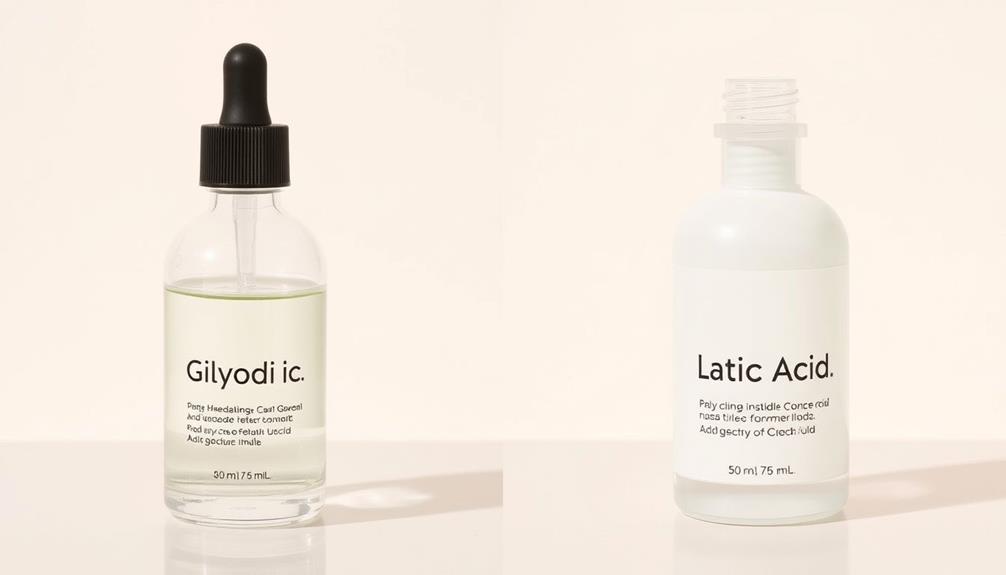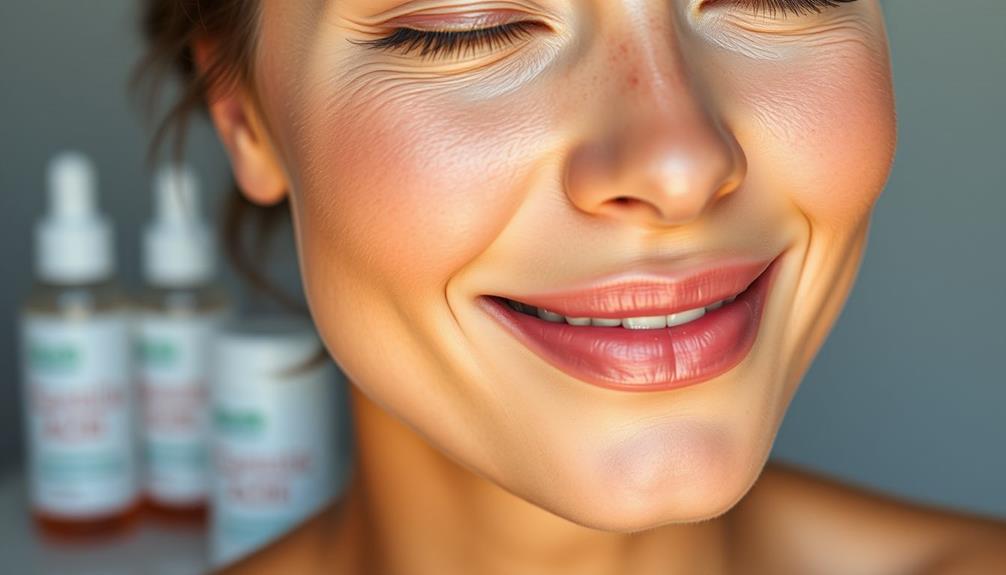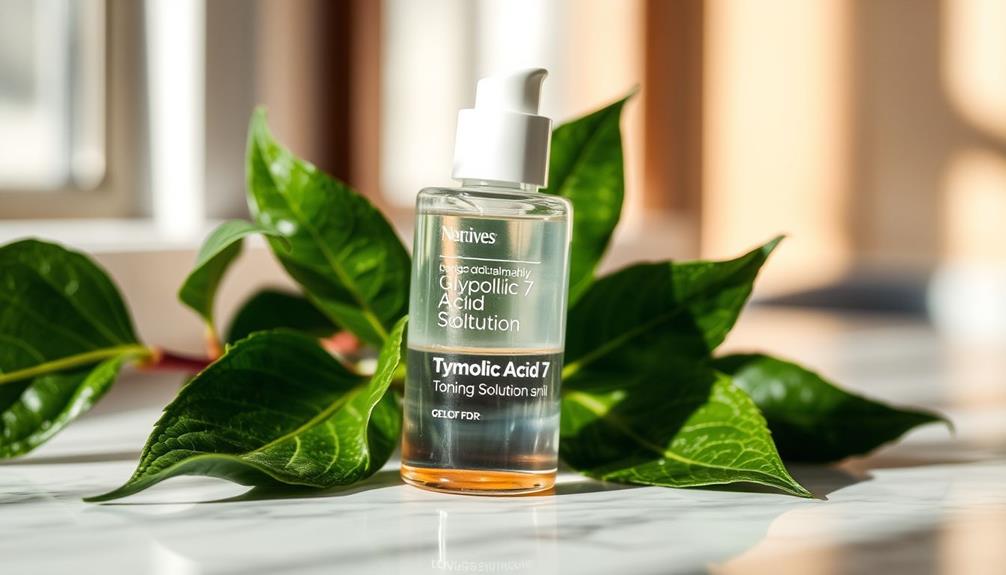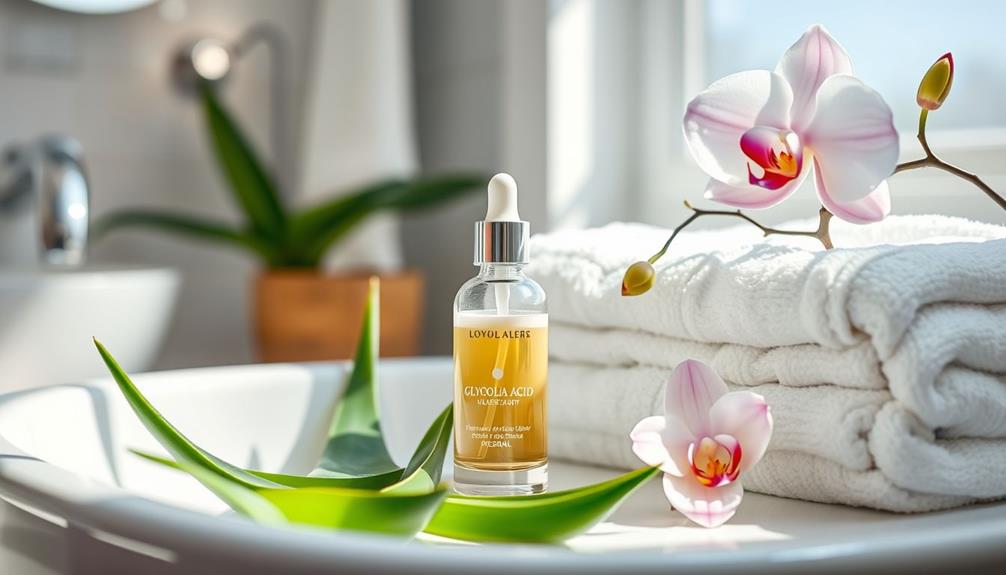When deciding between glycolic and lactic acid, think about your skin type and concerns. Glycolic acid is a potent exfoliator ideal for normal to oily skin, offering rapid results and improving texture. However, it can irritate sensitive skin. On the other hand, lactic acid provides hydration and is gentler, making it great for dry or sensitive skin. Both acids help with hyperpigmentation, but they work differently. By evaluating your skin's needs, you can choose the right acid for you. There's so much more to explore about their benefits and application tips.
Key Takeaways
- Glycolic acid is best for normal to oily skin, offering deeper exfoliation and faster results, while lactic acid is gentler and ideal for sensitive skin.
- Lactic acid provides hydration and improves skin texture, making it suitable for dry skin types, with less risk of irritation.
- Glycolic acid effectively treats hyperpigmentation and acne, promoting collagen production for a brighter complexion.
- Patch testing is crucial to assess individual skin sensitivity before using either acid.
Overview of Lactic Acid
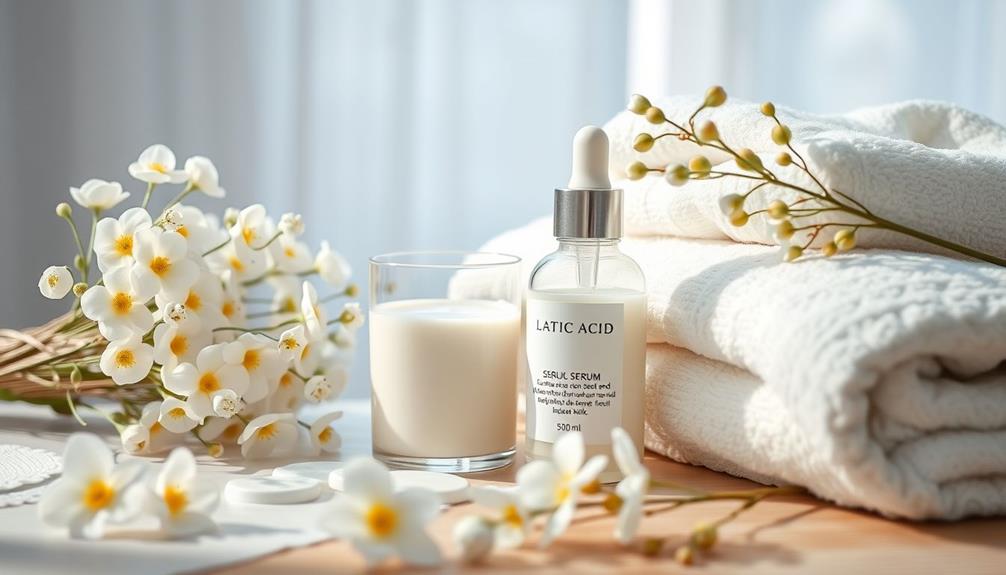
Lactic acid, a gentle alpha-hydroxy acid derived from fermented dairy, effectively exfoliates and hydrates your skin. Its mild exfoliating properties help improve skin texture by sloughing off dead cells, promoting cell turnover with each use.
If you have dry and sensitive skin, you'll appreciate lactic acid's unique moisturizing properties, which help maintain hydration levels while providing gentle exfoliation. Additionally, lactic acid can complement other skin treatments, such as aromatherapy benefits, enhancing your overall skincare routine with its soothing effects.
Incorporating lactic acid into your routine can visibly enhance your skin's clarity in as little as four weeks. This makes it a popular choice for anti-aging products, as it helps reduce the appearance of fine lines and uneven tone. By supporting the skin's natural moisture barrier, lactic acid guarantees your skin stays soft and supple, making it an ideal option for those who struggle with dryness.
With consistent use, you'll notice improved skin texture and a brighter complexion, all without the irritation often associated with stronger exfoliants. Whether you're looking to revitalize your skin or simply maintain its health, lactic acid can be a powerful ally in your skincare arsenal.
Overview of Glycolic Acid
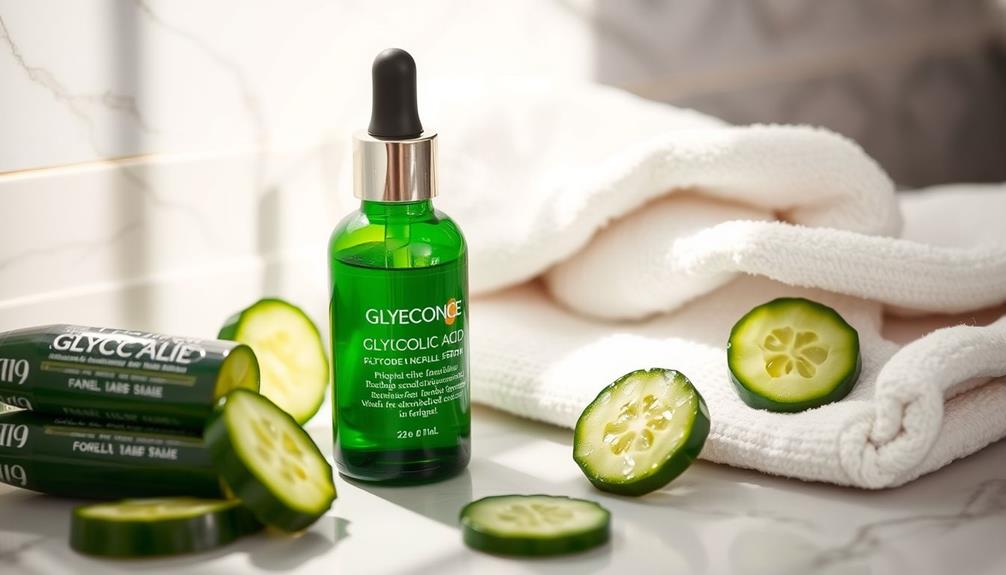
Glycolic acid, derived from sugar cane, is the smallest alpha-hydroxy acid (AHA), giving it the ability to penetrate deeper into your skin for more effective exfoliation. This powerful exfoliating agent works by sloughing off dead skin cells, promoting cell turnover, and revealing a fresher, brighter complexion.
Additionally, many skincare enthusiasts incorporate natural alternatives like essential oils to enhance their routines, such as essential oils for relaxation to complement the benefits of glycolic acid.
By incorporating glycolic acid into your skincare routine, you can stimulate the production of collagen and elastin, which are essential for maintaining skin elasticity. This can help reduce the appearance of fine lines and wrinkles, making your skin look younger and healthier.
Additionally, glycolic acid is known for its effectiveness in treating hyperpigmentation and acne, helping to even out your skin tone and improve clarity.
You'll find glycolic acid available in various formulations, ranging from lower concentrations in over-the-counter products to higher concentrations used in professional peels. Depending on your skin type and concerns, you can choose the right product to fit your needs.
As you explore the benefits of glycolic acid, you'll likely appreciate its ability to transform your skin, making it a popular choice among skincare enthusiasts.
Key Benefits of Lactic Acid
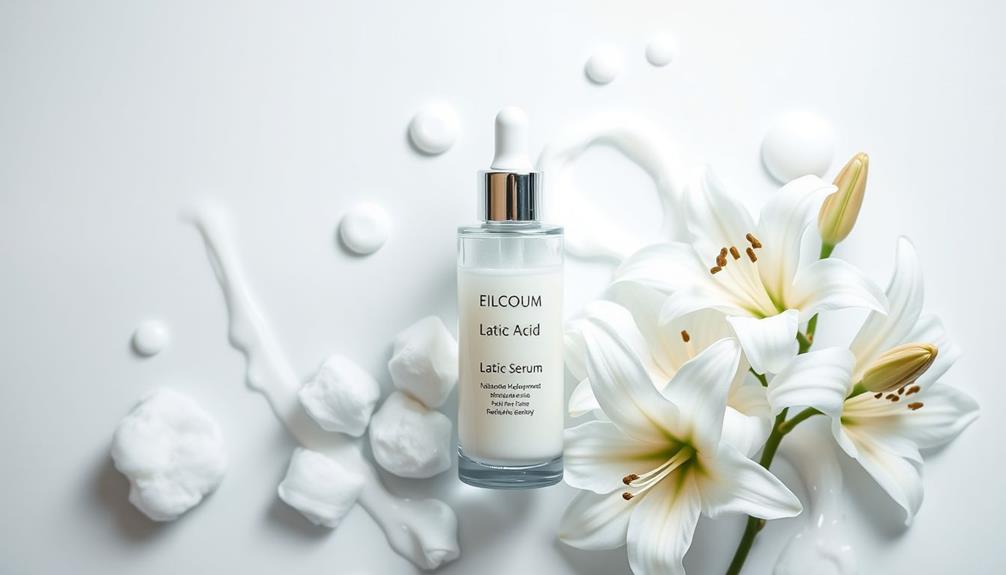
Incorporating lactic acid into your skincare routine offers a gentle yet effective way to exfoliate and improve your skin's overall texture and hydration. As a mild alpha-hydroxy acid (AHA), lactic acid is perfect for sensitive skin types, providing all the benefits of chemical exfoliants without the irritation often associated with glycolic acid.
Additionally, incorporating mindful practices in your skincare routine can enhance your overall well-being, similar to how stress management techniques can improve skin health.
Here are some key benefits of using lactic acid:
- Hydrating Properties: Lactic acid enhances moisture retention in your skin barrier, making it ideal for dry or sensitive skin.
- Improves Skin Tone: Regular use can smooth fine lines and diminish dark spots, revealing a more even complexion.
Clinical studies have shown that you can see significant improvements in skin texture and clarity within just four weeks.
Key Benefits of Glycolic Acid

Experience remarkable skin transformation with glycolic acid, known for its deep penetration and powerful exfoliation benefits.
This alpha-hydroxy acid (AHA) has a small molecular size, allowing it to work effectively within the skin layers. You'll notice improved skin clarity as glycolic acid reduces the appearance of fine lines and corrects skin discoloration, making it a staple in anti-aging skincare routines.
In addition to its exfoliation benefits, glycolic acid stimulates collagen production and enhances hydration through the boost of hyaluronic acid. This means your skin not only looks smoother but feels plumper and more youthful.
If you have acne-prone skin, glycolic acid's antibacterial properties can help treat blemishes and diminish post-blemish marks, leading to a clearer complexion over time.
Clinical studies show that consistent use of glycolic acid can greatly improve rough texture and skin discoloration, making it suitable for various skin types.
By incorporating glycolic acid into your skincare routine, you're investing in a product that effectively addresses multiple skin concerns, from fine lines to hydration.
Get ready to reveal your best skin yet!
Comparing Efficacy and Sensitivity

When considering glycolic and lactic acid, you'll want to think about your skin's sensitivity and how each acid exfoliates.
Glycolic acid can deliver faster results but may irritate sensitive skin, while lactic acid offers a gentler approach.
Understanding these differences will help you choose the right product for your skincare routine.
Skin Sensitivity Considerations
Choosing between glycolic and lactic acid involves balancing their efficacy with your skin's sensitivity, as each acid affects different skin types uniquely.
Glycolic acid, due to its smaller molecular size, penetrates deeper and provides quicker results, but it can also lead to irritation, especially for sensitive skin types.
On the other hand, lactic acid offers a milder exfoliation, making it a great option for dry, sensitive, or mature skin.
Here are some key points to evaluate:
- Patch Test: Always perform a patch test to assess your individual skin sensitivity before fully applying either acid.
- Milder Option: Lactic acid is generally more tolerable for sensitive skin types, thanks to its hydrating properties that help maintain moisture while exfoliating.
Ultimately, choose based on your skin type and specific needs. Understanding how each acid interacts with your skin can lead to more effective and comfortable results.
Exfoliation Strength Differences
Understanding the differences in exfoliation strength between glycolic and lactic acid can help you make an informed decision based on your skin's tolerance and desired results.
Glycolic acid, with its smaller molecular size, penetrates deeper and provides a more intense exfoliation. This can lead to quicker improvements in skin texture and clarity. However, if you have sensitive skin, glycolic acid may cause redness or irritation.
On the other hand, lactic acid offers gentler surface exfoliation and is generally better tolerated by sensitive skin types. While it may take longer to show visible results, lactic acid reduces the risk of adverse reactions. It also provides hydration benefits, making it ideal for dry skin types seeking to combat fine lines.
Both acids effectively address concerns like hyperpigmentation, but the choice largely depends on your skin's sensitivity. Always consider patch testing before full application to gauge your skin's responsiveness to either chemical exfoliation. This step is essential in ensuring that you select the right exfoliant for your skin's unique needs without causing irritation.
Recommended Usage Approaches
Comparing the recommended usage approaches for glycolic and lactic acid can help you effectively tailor your skincare routine based on your skin type and sensitivity levels.
If you have sensitive skin or dry patches, lactic acid is your best bet. It's milder and offers hydration, enhancing your skin's moisture barrier while providing notable skin benefits.
Glycolic acid, on the other hand, is better suited for normal to oily skin that can handle deeper exfoliation. Its smaller molecular size allows for quicker penetration, leading to faster improvements in the appearance of fine lines and overall skin texture.
Here are some key considerations:
- Patch Testing: Always patch test either acid to gauge your skin's sensitivity.
- Efficacy: Glycolic acid may show quicker results, while lactic acid requires consistent use for visible changes.
Recommended Products for Lactic Acid

When looking to incorporate lactic acid into your skincare routine, consider these effective products that cater to various skin needs. Lactic acid offers numerous benefits, such as improving the appearance of uneven skin tone and gently exfoliating the skin. Here are some recommended products:
| Product Name | Key Benefits |
|---|---|
| Super C Brightening Serum | Targets dark spots, promotes a radiant complexion |
| Advanced Even Tone Day & Night Treatment | Addresses hyperpigmentation, improves uneven skin tone |
| Radiant & Bright Glowing Moisturizer | Enhances texture, hydrates dry skin |
| Milk-Peel Gentle Exfoliating Toner | Gently exfoliates, ideal for sensitive skin |
These products utilize lactic acid, which is milder than glycolic acid, making them perfect for those new to chemical exfoliants. The Milk-Peel Gentle Exfoliating Toner is particularly suitable for sensitive skin, allowing you to exfoliate without irritation. By adding these lactic acid products to your skincare routine, you can achieve a smoother, brighter complexion while addressing common concerns like uneven skin tone and hydration.
Recommended Products for Glycolic Acid
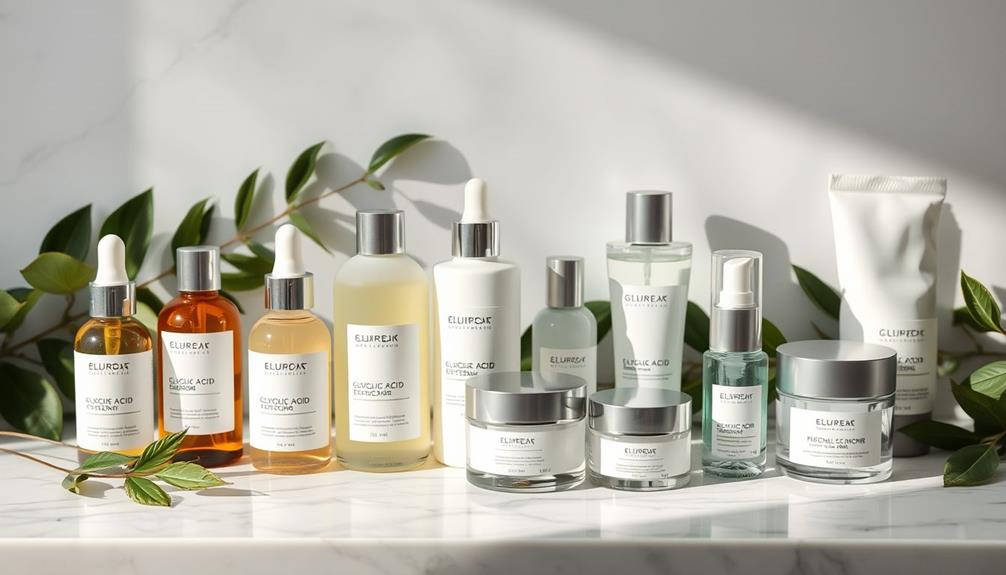
Glycolic acid products can effectively enhance your skincare routine by targeting concerns like uneven skin tone and signs of aging. These products offer numerous benefits, particularly for oily skin types, thanks to their powerful chemical exfoliation properties. By incorporating glycolic acid into your regimen, you can improve skin clarity and the overall appearance of your skin.
Here are some recommended glycolic acid skincare products:
- Clear Skin Cleansing Bar: This bar is formulated with glycolic acid to target oily skin and breakouts, providing effective exfoliation and cleansing.
- Reti-Glow™ Gentle Resurfacing Night Oil: Combining glycolic acid with nourishing ingredients, this oil helps smooth skin texture and promotes an even skin tone overnight.
Consistent use of these glycolic acid products can lead to remarkable results, making them a popular choice for those looking to enhance their skincare routine and combat signs of aging. The benefits of glycolic acid include its ability to exfoliate the skin, promoting cell turnover and revealing a brighter, more even complexion. Additionally, it can help improve the appearance of fine lines and wrinkles, as well as minimize the appearance of pores. With regular use, glycolic acid can significantly improve the overall texture and appearance of the skin, making it a valuable addition to any skincare regimen.
Application Tips for Both Acids
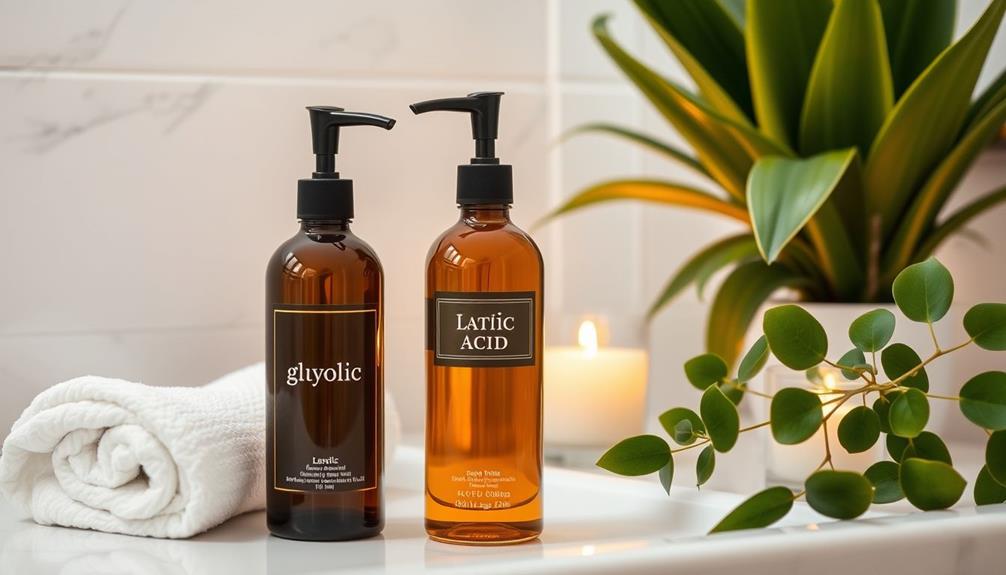
To get the most out of lactic and glycolic acids, start with a lower concentration and use them every other night to see how your skin reacts. This approach helps minimize irritation while evaluating your skin's tolerance.
Always apply these acids in the evening; this timing reduces sun sensitivity and protects your skin during the day.
Before diving into your new skincare routine, perform a patch test on a small area of skin. This step is essential to monitor for any adverse reactions to lactic or glycolic acid.
Once you're ready to apply, make sure you let the product absorb fully into your skin for about 10-15 minutes before layering other products.
To maintain your skin barrier's integrity, avoid using both acids on the same day. Instead, alternate them to prevent over-exfoliation, which can lead to irritation.
Finally, don't forget to follow up with a broad-spectrum sunscreen during the day, as both acids can increase your skin's sensitivity to the sun.
With these application tips, you'll effectively incorporate lactic and glycolic acids into your skincare routine.
Professional Guidance and Consultations

Consulting with a licensed aesthetician can help you determine whether glycolic or lactic acid is the best fit for your skin type and concerns. With their professional guidance, you can navigate the complexities of skincare products and find what truly works for you.
Here's how skincare professionals can assist you:
- Virtual consultations: Enjoy personalized advice from the comfort of your home, making it easy to discuss your skin concerns.
- Skincare quizzes: Identify your specific skin needs and understand the appropriate use of glycolic and lactic acids, guaranteeing you make informed choices.
Regular follow-ups with your aesthetician are essential to monitor your skin's progress. They can adjust your treatment plans based on your skin's response and any sensitivities you may have.
This ongoing relationship guarantees that your skincare journey is effective, safe, and suited to your individual needs. So, don't hesitate to seek professional guidance—it's an investment in the health and appearance of your skin!
Frequently Asked Questions
Should I Use Glycolic or Lactic Acid?
You should choose glycolic acid if you want deeper exfoliation and quicker results, especially for aging or pigmented skin. If your skin's sensitive or dry, lactic acid's gentler, hydrating properties might be better for you.
Which Is Best for Hyperpigmentation, Glycolic Acid or Lactic Acid?
If you're targeting hyperpigmentation, glycolic acid's deeper penetration and faster results make it the better choice. However, if you have sensitive skin, lactic acid can help improve tone and texture without irritation. Consider your skin's needs.
Is Lactic Acid or Glycolic Acid Better for Keratosis Pilaris?
When treating keratosis pilaris, you'll find lactic acid gentler on sensitive skin, while glycolic acid penetrates deeper for quicker results. Experimenting with both might give you the best chance for smoother skin overall.
Which Exfoliating Acid Is Best for Hyperpigmentation?
When tackling hyperpigmentation, you'll find glycolic acid's deeper penetration effective, while lactic acid's gentleness suits sensitive skin. Consider incorporating both for enhanced results, as they complement each other's strengths in promoting clearer, more even-toned skin.
Conclusion
So, whether you choose lactic or glycolic acid, just remember: your skin won't magically transform overnight.
If you're expecting to wake up with a flawless complexion after one application, you might want to rethink that strategy.
Both acids have their perks, but patience is key.
Embrace the journey, and don't forget to consult a professional—after all, they didn't spend years in school just for you to wing it with a bottle in hand!
